Paid Search Monitoring: The Complete Guide to Smarter PPC Management

Anyone who has ever run PPC campaigns knows how effective they can be, but also how costly they are compared to organic SEO campaigns. Advertisers pay for fast and targeted delivery of their ads, and they want a maximum return on their money.
This is where paid search monitoring comes into the spotlight. Your search ads generate lots of data, starting with customer impressions, clicks, and all the way to conversions. This data represents a fruitful ground for campaign optimization, if only you know how to track and analyze it properly.
Check out our guide to get an in-depth understanding of how paid search monitoring works and how you can leverage it to improve your search ad performance. Don’t skip the sections about AI automation and the best tools for PPC — those are packed with actionable insights you can apply to your campaigns right away.
Introduction to paid search monitoring
This section was initially intended for those who want to refresh the basics, but it will likely end up being useful for everyone. Why? Because, without understanding how paid search works and the advantages it gives, your PPC data will tell you little about what really drives results.
What is paid search monitoring?
Paid search monitoring is the art and practice of tracking, analyzing, and improving one’s ad performance in search engines’ results. Ideally, it’s an ongoing practice, a process of building a system that learns from every click and conversion.
The popularity of paid search ads is skyrocketing: last year, the IAB/PwC report showed U.S. digital ad revenue hit $259B. That’s how much money flows through channels that need real measurement.
Advertisers run their ad campaigns on search engines like Google, Bing, and Yahoo; that’s why this practice is also known as search engine marketing (SEM).
Perhaps, an even more famous term used is pay per click (PPC), which literally means that you pay for every click that users make on your paid ads on search engines.
Digital marketers are highly creative people, and they rarely stop using one or two terms. That’s why a whole plethora of terms emerged, and everyone is free to use whichever one they like most: paid search tracking, search advertising monitoring, paid search performance tracking, PPC brand monitoring, search campaign monitoring, ad performance tracking, to name a few.
How paid search works
When we talk about paid ads, keep in mind that paid ads typically work on two platforms:
- Google Ads (formerly AdWords): the largest and most widely used platform.
- Microsoft Advertising (Bing Ads): displays ads on Bing, Yahoo, and other Microsoft partner sites.
Everything starts with the right keywords. Advertisers choose keywords that most closely match their products and services.
However, that’s not all. For PPC ads to work, we need ad auctions. Those are run by Google or Bing, and they do it live: every time a user searches for the right terms (keywords), search engines run an instant auction.
The winners of the auctions get their ads displayed for users searching for relevant keywords. Winners are chosen based on their bid amount (they bid for keywords in advance) and the relevance of the search terms to their products and services.
So, auctions decide which ads show and at what price. Relevance and experience are levers you can actually control. How? By monitoring your keyword performance, ad relevance, and landing-page experience.
Essentials to monitor paid search performance at the core level:
- Search term coverage and negative keyword hygiene: ensure your ads trigger for relevant queries, while filtering out irrelevant traffic.
- Ad relevance, extensions, and landing-page continuity: align messaging, visuals, and offers across ads and landing pages for stronger engagement.
- Impression share vs. cost to spot efficient headroom: compare visibility against spend to uncover opportunities for affordable growth.
Continuous monitoring and ongoing improvements, that’s what matters the most. Finish each review with a single action you can implement today.
Incremental improvements will ensure that every time someone clicks on your ad (and you pay for that click to Google or Bing), you end up with a real customer who converts on your site.
Why monitoring matters
Ad performance tracking narrows the space between spend and outcome. With the thorough and regular monitoring and testing, you learn which ideas deserve scale.
Here are some compelling reasons why businesses use PPC monitoring:
- To appear instantly in search results.
- To drive qualified traffic ready to convert.
- To test new products, messages, or markets quickly.
- To complement organic SEO with measurable, controllable reach.
Continuous performance tracking and experimentation that follows also gives teams a common language for trade-offs.
What begins as regular ad performance tracking soon evolves into meaningful, long-term gains such as:
- Cleaner budgets with fewer leaks.
- Messages that align with intent and reduce bounce.
- Better forecasting from consistent trend lines.
This gives your brand more credible visibility and a brand experience users actually trust.
Core elements of PPC monitoring
Attentive readers must have noticed that we’ve used several concepts to describe what paid search monitoring is and how it works. These are keywords that help connect users’ queries with advertisers’ offers, landing pages where users initially “land” upon clicking on an ad, and a bidding mechanism that determines which ads appear in search results and how much each click ultimately costs.
Let’s now explore each of these core PPC monitoring elements, focusing on the practical aspects to help you improve your search ad management practices.
Keyword performance
Keywords are where people tell you what they want, in their own words. Your job is to meet them there with the right offers. For that, you need to use the exact customer's language throughout your ad copy and all its elements, including headlines, visuals, body, extensions, and so on.
Starts with separating genuine buying intent from broad research. Not every high-volume term deserves your wallet.
Here is a quick way to sort your keyword pile:
- Label customer queries by intent: informational, commercial, transactional, and navigational before touching bids.
- Put your best-performing keywords into separate ad groups for better control.
- Exclude irrelevant searches like wrong topics, plural forms, or job-related queries to save budget.
- Match ad text to the exact phrases people actually use.

Source: Wordstream
When you lean on pay per click monitoring, patterns appear fast. A handful of themes will carry most of your results; give them a cleaner structure and the best landing paths.
If a keyword is close but not converting, don’t just lower the bid; instead, refine the keyword. For that, you may need to investigate why. Oftentimes, reasons like wrong promise, weak page proof, or unclear next step surface rather quickly.
The key KPIs to track:
- CTR and conversion rate by intent bucket.
- Cost per acquisition (CPA) and return on ad spend (ROAS) by keyword and match type.
- Impression share and top impression share on priority terms.
- Quality Score components and trend.
- Negative additions and spending saved.
- Assisted conversions from non-brand terms.
Don’t try to embrace and master every metric out there at first. Keep the map small enough to manage and big enough to learn from. The advantage of this approach is that you’ll feel more confident and organized when each keyword has a clear label, an understandable goal, and an easy plan to follow.
Ad copy effectiveness
Ads tend to quickly oversaturate the user’s informational space. To win in the attention front, ads must be really helpful, to the point, and with a sense of humor (to not bore the user).
Therefore, an ideal ad copy nails the user's pain points and sets expectations. If your ad promises speed, the page must feel fast; if it promises value, the offer must be obvious.
Search advertising monitoring tells you which promises resonate and which create drop-off. That’s the difference between high CTR with high bounce, and high CTR with high dwell time and real leads.
Run every ad copy through the following skeptical lens and proceed to production only if you get positive answers on every one of these points:
- “Does my headline reflect the user’s pain points?”
- “Does my ad copy entertain (make the users smile)?”
- “Is there a concrete benefit or an interesting statistic in the first line/paragraph?”
- “Do additional paragraphs help with the product understanding?”
- “Would I click this if I had this exact problem?”
When paid ads monitoring highlights fatigue, rotate themes rather than synonyms. In most cases, it pays off to make radical changes, rather than trying to fix what is already not performing well. New proof points, time frames, or risk reducers usually refresh performance more than word swaps.
Also, make it a habit to document your “why it won” notes. That knowledge compounds across campaigns and teams, improving ad campaign management and creative handoffs.
The key KPIs to track:
- CTR and absolute top impression rate by ad theme.
- Conversion rate and lead quality by ad group.
- CPC trend vs. Quality Score (ad relevance subscore).
- Asset performance (sitelinks, callouts, structured snippets).
- Bounce rate and time on page by message.
- Incremental lift from new ad variants vs. baseline.
Treat tests as conversations with the market. Try to stay specific at all times, keep your stakes clear, and retire tired angles when needed.
Landing page quality
The landing page should feel like a natural continuation of the ad. If users must hunt for value, they won’t stay. Attention span is getting shorter and shorter; nobody has an extra second anymore to linger on a page for no reason.
How do you tackle this? Start with a message match, then optimize for speed, often implying greater simplicity. Fancy features can wait, but long explanations, complex terms, and sidenotes must be prohibited.
Tidy the experience with this quick checklist:
- Repeat the ad promise as early as possible, e.g., in the H1, near verbatim.
- Make the primary CTA obvious and early.
- Place proof (ratings, logos, short FAQs) near the decision point.
- Check mobile forms and Core Web Vitals first.

Source: Omnisend
Optimizing for mobile usage is critical, as most users these days access the web from their smartphones. Monitor and analyze your front performance, key buttons, and navigation menus, as well as graphical elements, and prioritize their improvement if any issues are found.
If engagement is good, but conversions lag, check whether the offer is underpowered or poorly sequenced; a shorter path or staged form can help.
When bounce is isolated to one device or geo, inspect layout shifts, translation gaps, and script conflicts; the fix is often small but meaningful.
The key KPIs to track in landing page quality monitoring:
- Conversion rate (primary and micro) by device.
- Bounce rate, scroll depth, and click-map density.
- Form completion and field-level drop-off.
- Largest contentful paint (LCP), interaction to next paint (INP), and server response time.
- Exit rate from pricing, comparison, and FAQs.
- Revenue per visit and assisted conversions.
Contrary to the popular myth, great landing pages reduce decisions; they don’t multiply them. Make the next step obvious for your visitors, and conversion becomes much easier to attain.
Budget and bid performance
Budgets and bids are no less important than ad copy and keywords. Basically, they decide what gets a chance to win. Therefore, check their performance regularly and treat them like steering, not set-and-forget switches.
💡 Quick insight: Having simple, clear rules for budgets and bids helps you make faster, easier decisions and keep everything under control.
These guidelines will help you manage bids and budgets more effectively:
- Scale where adding spend keeps cost per acquisition (CPA) and return on ad spend (ROAS) stable.
- Stop spending on campaigns that consistently fail to meet performance goals.
- Set a limit on maximum cost per click (CPC) and cost per acquisition (CPA) to prevent overspending.
- Make small manual adjustments; they help automated systems learn and perform more accurately.
And when leadership asks, “Why this budget,” your campaign management notes plus trend charts provide a clear, defensible story. Budgeting needs discipline; you cannot let your bidding process go by itself without your watchful eye on it (smart dashboards will help).
The key KPIs to track:
- Return on ad spend (ROAS) and cost per acquisition (CPA) by campaign, audience, device, and time of day.
- Impression share lost to budget vs. lost to rank. That will show whether you’re missing ad impressions because the budget ran out or because competitors outranked you.
- Pacing versus plan; marginal cost per click (CPC) and cost per acquisition (CPA) at incremental spend levels.
- Bid strategy target versus actual target cost per acquisition (tCPA), target return on ad spend (tROAS), and volatility.
- Conversion share and revenue mix from top segments.
- Frequency of manual overrides and their impact.
Take two or three KPIs from this list at first and work with them for a while. You don’t need to measure everything at once; only those metrics that support your strategic goals.
With consistent pay per click monitoring and thoughtful management, you’ll fund the right ideas and keep risk contained.
Competitor benchmarking and analysis
A substantial part of the success in paid search monitoring rests on one’s ability to navigate the market. Besides knowing your own strengths and weaknesses, it also entails understanding the competition.
In this chapter, we’ll review the essential elements of competitor benchmarking and explain how to utilize the obtained insights to improve your PPC strategy.
Tracking competitor ads and keywords
On the market, you are far from being alone. But that doesn’t mean you have supporters; mostly rivals and naysayers to your success. The good news is that you can turn this to your advantage. How?
Your rivals are constantly running experiments in the same auction. Watching your competitors is a shortcut to understanding what the market rewards right now.
Focus on consistency: which messages repeat, which pages keep returning, and which queries show them day after day. That consistency usually points to what supports their brand and margin. Besides, you don’t need to research random behaviors and campaigns. Nor pay attention to outliers in competitor paid ads.
Save this working checklist to always collect what matters without overwhelm:
- For priority queries, save top ads with timestamps and placement.
- Log frequency of promotions, seasonal offers, and limited-time angles.
- Log extensions and any new assets or formats.
- Map destination pages and first-screen content.
- Note bidding posture by query class: exact, phrase, broad with negatives.
- Save SERP screenshots for major queries to see placement and assets.
After a few weeks of PPC monitoring, a clear picture forms: recurring value props, favored landing templates, and the handful of queries your rivals defend at all costs. That helps you choose where to compete directly and where to differentiate.
Stay curious rather than reactive. The point is to find edge cases you can own, not to chase every move a rival makes.
Benchmarking performance metrics
As the above example with keywords has shown, benchmarks work when you compare apples to apples. Pick the same queries, devices, and locations, and use the same time windows.
Treat stability as a result. If you hold steady while rivals swing, your account structure and pages are probably doing their job.
At first, agree on definitions, then monitor changes with short annotations. For example, if a competitor’s conversion rate outpaces yours on identical queries, look at message match and above-the-fold clarity before adjusting bids. If your CPC is higher, but your average order value is meaningfully stronger, fund the difference with intent.
💡 Quick insight: Remember, benchmarking is a compass, not a scoreboard. Use it to decide the next controlled step, for which you’ll need to act; definitely not sit and wait.
These metrics typically turn observation into practical comparison:
- Visibility: top-of-page rate and absolute top presence by query group.
- Efficiency: cost per click (CPC) and cost per acquisition (CPA) under similar volumes.
- Quality: conversion rate (CR) by message theme and landing template.
- Depth: lead quality or average order value by segment.
- Momentum: trend of results during promotions or seasonality spikes.
- Consistency: variance of results week to week under similar inputs.

Source: Mainstreetroi
Once defined, monitor these lines and annotate changes. When a rival’s CTR jumps only on mobile, inspect their mobile page and extensions. If your CPA rises but your order value doubles, the trade-off might still be right.
Tie each comparison back to one actionable question. Should you change the message, the route, or the funding? Decide, test, and record the outcome, so the next decision starts from facts.
Adjusting strategy based on competitor insights
Suppose you’ve discovered that your competitors are doing very well and outperforming you in the search ads department. What are your actions? Of course, pushing the envelope to become better than your rivals.
However, what if you’ve just discovered that your direct competitors are far behind you? What are your actions then?
Celebrate and rest on your laurels? You can do that, but only to cheer up and motivate your team for a short while. But a far better strategy is to analyze what makes you gain the upper hand and develop and capitalize on this strength.
Always use competitor patterns to sharpen your own plan, not to chase theirs. Begin with your economics and the promises you can keep every day.
Let paid search monitoring point out which lever needs attention: messaging, routing, or budget. If rivals lean on discounts, test certainty, or service benefits, if they take advantage of broad terms, own the specific queries where buyers act.
💡 Quick insight: Pick the advantages of your rivals that you can reverse quickly. New proof, a tighter headline, or a smaller form field can give you a lot with little risk.
As results stabilize, either scale the change or replace it. The discipline is what keeps you moving forward without noise. Modern digital strategies are live processes, and as such, they require continuous improvements based on real-time data and insights.
Automation and AI in paid search monitoring
By 2026, artificial intelligence (AI) will completely dominate marketing. Autonomous AI software will be better than most humans at creating ad copies, delivering them to customers (while providing the best customer support ever), and personalizing that content for a better customer experience.
That’s the near future, not some distant one. But for many content creators, it has already become a reality. If you don't seize this unique moment to leverage AI for your benefit, your rivals will do that, and you will be left far behind. Now is the right moment to learn and harness the power of AI.
Smart bidding strategies
“Smart” in the context of bidding strategies is not just some fancy word with little practical value. On the contrary, it’s grounded in AI technologies and spells greater efficiency and speed.
Smart bidding adjusts to live conditions you can’t see fast enough. However, it works best when your definition of “success” is crystal clear.
💡 Quick insight: Your best strategy with smart bidding? Focus on clear goals, supply trustworthy conversion data, and let the system learn from real results.
Consider these starter steps that make automation reliable:
- Choose one conversion goal with truthful value: Focus on one clear conversion and assign it a realistic value.
- Define and add the optimal audience profiles: Specify which customer profile is likely to deliver better value, e.g., with higher engagement, loyalty, or a stronger track record of past purchases.
- Create cost per click (CPC) and cost per acquisition (CPA) boundaries for guardrails: Set spending limits to prevent your bids and costs from getting too high.
- Add negatives to cut predictable waste: Exclude irrelevant keywords or searches that don’t lead to useful results.
If search engine marketing campaign monitoring shows instability, audit data first: events, values, and routing. Then make small target changes rather than full resets; continuity helps the model.
Machine learning in ad optimization
Machine learning (ML) would look like a miracle to a 20th-century person. A software that runs on ML utilizes big data to essentially learn and improve itself without significant human support. In paid search monitoring, where data is abundant, this changes everything.
ML weighs thousands of tiny signals at auction time and favors the combinations that usually convert. However, your software must pass accurate conversions and values, or the model optimizes the wrong thing.
Here are a few examples of the modern ML-based software that is widely used for ad optimization:
- Google Ads Smart Bidding — adjusts bids automatically in real time using conversion data and contextual signals.
- Meta Advantage+ — tests audiences and ad creatives on its own to find the best mix for results.
- Adobe Advertising Cloud — predicts campaign outcomes and shifts budgets across channels to improve performance.
- Microsoft Advertising Smart Bidding — fine-tunes bids on Bing using patterns from user intent and device behavior.
Nevertheless, each of these tools is currently far from showing agentic (i.e., autonomous) behavior. They still rely heavily on human management and oversight. It’s better to think of ML as a quick analyst: fast with patterns and summaries, but dependent on your direction.
AI-based performance forecasting
Self-learning is not the only capability of AI. It is also very good at forecasting, not perfect, but certainly better than most humans are with their gut feelings and a tendency to pursue “bright” ideas, no matter the circumstances
By the end of 2025, AI-based forecasts will already help choose better PPC paths, for instance, how much growth and at what efficiency, rather than predict exact numbers. In most cases, that’s enough to enable humans to make smarter decisions.
Here are the data types, or inputs, that keep forecasts practical and accurate:
- Include past seasonality and promotion timing: Use data from previous years to understand repeating trends and peaks.
- Set cost per click (CPC) and conversion rate ranges: Give flexible ranges instead of one fixed number to reflect real-world changes.
- Add notes on any software or website updates: Record new tools or routing changes that could affect campaign performance.
- Compare base and optimistic scenarios: Build two versions of your forecast — one realistic and one showing your best possible outcome.
If the projection misses, don’t rush into emotional decisions of stopping the whole process, changing methods, or cutting the budget. Instead, check assumptions and run the model the second or third times. Save what you learned, so the next plan is a little wiser.
👇 Final thought: Keep your forecasting approach consistent and let every comparison between assumptions and outcomes quietly improve the next model.
Automation pitfalls and human oversight
Automation magnifies both good and bad inputs. It’s fair to say that it's a double-edged sword in the world of paid search analytics. Without light guardrails, small mistakes become costly habits.
AI is not fully autonomous and reliable enough to entrust it with the full paid search campaign process. We are not there yet. So far, you should always set who checks what, and how you’ll respond when results look off.
These are the places where issues often start (and are easy to catch):
- Tracking changes that distort values: It’s easy to overlook tracking when the site changes — test it every time.
- Target shifts that reset learning: Give campaigns breathing room between goal updates so automation can learn properly.
- Negative gaps that invite noisy queries: Add or update negative keywords often to keep irrelevant clicks out.
- Rolled-up reports that hide device or region outliers: Always break down reports by device and region to see what’s really going on.
When paid search tracking exposes anomalies, always try to repair inputs first before swapping entire strategies. Promptly record what broke and what fixed it; next time, you’ll resolve it faster.
👇 Final thought: Let automation handle the speed, but keep humans in charge of understanding, context, and thoughtful decisions.
Top PPC monitoring tools
Picking platforms shouldn’t feel like assembling a cockpit. You want a stack that shows you what’s happening, why it’s happening, and what to do next. If you’re weighing the best tools for PPC, start with the essentials and add only what removes real friction.
Good stacks make search campaign monitoring and paid ads monitoring feel calm: trustworthy data, useful automation, and reports that lead to action.
Google Ads and Google Analytics
This pair anchors most accounts for a reason. Google Ads explains the auction; Google Analytics explains behavior after the click. Together, they close the loop between intent and outcome and work as a single tool for day-to-day decision-making.
Keep the setup simple. Define conversions once and value them realistically. If you change the funnel, update the map. Google’s software isn’t a magic wand; it cannot do everything for you (at least not yet), and it surely can’t fix unclear goals.

Source: Wedevs
How to get real value from the pair:
- Query clarity: See which terms deserve budget and which need negatives.
- Path checks: Confirm the ad promise appears in the first screen of the page.
- Attribution sanity: Use simple models when volume is thin; expand later.
- Audience loops: Build remarketing lists from behaviors that predict conversion.
When your paid search performance tracking shows rising CPC without better results, review page speed, form friction, and message match before tweaking bids.
If numbers shift suddenly, test tags; most “strategy problems” start as tracking problems.
👇 Final thought: Keep the following three report types close: intent, outcomes, and economics. Everything else can wait.
Third-party platforms
External platforms add portfolio thinking, scenario planning, and alerting that you won’t get natively. Pick a tool that helps your team act faster with fewer screens, not one that adds a second job.
Look for opinions you can tune. The best software suggests small, testable steps and shows the math behind them. As for the best PPC tool, it’s the one your team uses consistently because the numbers make sense and the workflow fits.
Capabilities that usually pay off:
- Budget portfolios: Move dollars where marginal return is still strong.
- Forecast bands: Compare “hold efficiency” vs. “buy volume” scenarios.
- Anomaly pings: Flags for broken tags or sudden CPC swings.
- Creative maintenance: Automatic nudges to rotate winners and retire laggards.
When choosing the right tool, know your budget capacity and never exceed what is affordable for your company at this growth stage. It’s better to be excellent at one, even a middle-class tool, than to struggle with operating a complex, premium segment one.
Here are a few examples of the affordable third-party platforms that you can try right away:
- Skai — Best for marginal-return portfolio bidding and cross-channel planning. Forecasts help you place dollars where they still create value.
- MarinOne — Best for multi-account orchestration. Consolidates networks and recommends changes with clear impact notes.
- Optmyzr — Best for operational efficiency. The tool optimizes every step of your paid search monitoring: from metric/KPI selection and market research to data analysis and distribution.
- Adalysis — The best tool for in-depth PPC analytics. Requires solid knowledge of the key ad metrics and economics. Live improvement suggestions included.
- Adobe Advertising — A powerful and highly specialized ad optimization tool that integrates with Adobe Analytics. Excellent for tracking competitor performance.
Integrating data sources
Organized and up-to-date data beats pretty, but outdated dashboards. What can you do about it? The first and foremost thing is to connect platform costs to analytics behavior and CRM outcomes, so ad campaign decisions are based on qualified value.
That system will make your brand feel trustworthy in the eyes of the customers, from the first click to renewal.
It’s important to agree on sources of truth and identifiers up front. Then wire your tools, so results flow back to the media: ads learn from real outcomes, not just proxy events.
Implement this lean integration plan:
- UTM discipline: Standard names, clean event firing, and no duplicates.
- CRM loopback: Push qualified status and corporate values to ad platforms.
- Time windows: Report with conversion lag in mind.
- Central layer: Keep all your campaign data and performance reports stored in one shared location for consistency and easier analysis.
With the above data loop closed, your PPC monitoring turns from “why is this weird?” to “what should we try next?” That’s a better place to work from.
👇 Final thought: Keep the docs short, keep the owners clear, and you’ll fix the rare breaks quickly.
8 common PPC tracking mistakes
Just because ad tracking is a seemingly straightforward process with lots of capable tools and AI by your side, it doesn’t mean people don’t make mistakes here.
On the contrary, the abundance of ad performance and user behavior data and data sources, and lots of manual work required by humans in managing the whole process — these factors make PPC tracking highly prone to mistakes. All sorts of mistakes, some attributed to human-made errors, while others have a largely technical origin.
To help you save a few headaches (and dollars), here’s what usually goes wrong:
1. Relying on vanity metrics — measuring fluffy concepts like engagement, or tracking everything at once. PPC generates an ocean of data, and those who try to capture everything usually lose focus and the competition.
The fix: It's better to track only a handful of KPIs that clearly connect with the ad campaign objectives.
2. Ignoring negative keywords — letting your ads appear for irrelevant or low-intent searches that waste clicks and budget. These “near misses” can quickly drain spending without adding value.
The fix is simple: review your search term reports regularly, identify phrases that don’t align with your offer, and add them as negative keywords to keep targeting clean and efficient.
3. Lack of conversion tracking setup — impressions, clicks, or dwell time might be truly important for your campaign performance, but if you don’t track the conversions — the only thing that brings real money — you’re taking paid search monitoring really wrong.
The fix: Set up clear conversion tracking for goal completions — purchases, sign-ups, demo requests, form submissions, and add-to-cart actions — to measure what truly drives revenue.
4. Overlooking search term reports — in other words, failing to review the actual search queries that triggered your ads. Marketers, like all humans, may be passionately pursuing their own vision, not paying attention to what the actual data shows. As a result, ads will show up for different terms, not triggering further clicks and not increasing conversion.
The fix: Review search term reports weekly to find irrelevant queries to exclude and high-intent ones to add as new keywords.
5. Failing to test new ad variations — some marketers stick to the profitable ad variants for too long, not paying attention that after a while, they lose effectiveness. Paid ads in search results reward ongoing experimentation on a weekly and daily basis.
The fix: A/B test different ad variants to see what works best. Leave out only those ads that help you achieve peak financial results and optimal budget management.
6. Ignoring mobile performance data — monitoring only the performance of your ads on the web. That’s easier, but it doesn’t show even half of the true picture, as most users access search engines via mobile devices these days.
The fix: Review mobile-specific metrics such as click-through rate, conversion rate, bounce rate, and page speed. Compare them with desktop results, then optimize ad copy, landing pages, and bids specifically for mobile users.
7. Not segmenting audiences properly — treating everyone similarly, showing the same ads for young and old customers, those who live in the USA and in India, with different interests, etc. Modern ads are long characterized by personalization and hyperpersonalization, where every user receives what they need at this given moment in time. Step out of this logic, and you are no longer competitive.
The fix: Segment audiences by demographics, location, interests, and behavior, then tailor ad copy and offers to match each group’s intent.
8. Setting unclear campaign goals — failing to describe what success looks like and tie this vision to tangible KPIs. This is nothing less than wasting budget and human resources.
The fix: Define clear, measurable goals upfront — like lowering cost per acquisition, increasing conversion rate, or boosting return on ad spend — and align all campaign actions to those KPIs.
Conclusion
PPC campaigns are widely used by marketers when they want quick and reliable results. The ideal use cases include launching or testing new products and services, entering new markets or new market niches, and quickly outperforming rivals, to name a few.
For what it's worth, the paid ads channel is a powerful promotional tool that requires close manual control and constant improvement. And the best way to ensure such improvements is through paid search monitoring.
Monitoring generates tons of useful data about product and brand performance, customer behaviors, which allows marketers to understand what truly drives clicks, conversions, and long-term ROI.
This guide has revealed many important aspects and nuances of paid ad campaign tracking, but the key takeaways are the following:
- To keep your ad budget under control, define clear goals.
- To turn your PPC data into real results, focus on KPIs connected to strategic goals, not broad metrics.
- Want to find your next growth move? Study competitors to uncover winning tactics and gaps to fill.
- Even with automation software and processes by your side, keep a human touch — it’s your best safeguard against costly mistakes.
As Peter Drucker once put it, “What gets measured gets managed.” When it comes to ad performance tracking, this principle applies even more — not just managing campaigns, but optimizing them for stronger, more consistent results over time.






